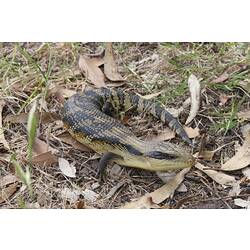General Description
Blue-tongues have large heads, long bodies and short legs and toes. The tail is shorter than the body, tapering to a point. They are silvery-grey to brown on the back with 7-9 irregular dark brown crossbands. The underside is white, grey or pale yellow. Male blue-tongues have a proportionally larger head and stockier body, but females grow slightly larger than males. Snout to base of tail length is up to 35 cm.
Biology
Blue-tongues eat a wide variety of foods including insects, snails, carrion, wildflowers, native fruits and berries. Their teeth and jaws are strong and they can crush snail shells and beetles. When threatened, blue-tongues turn towards the threat, open their mouth wide and stick out their broad blue tongue that contrasts vividly with their pink mouth. If this threat display does not frighten predators away, blue-tongues may hiss and flatten out their body, making themselves look bigger. Blue-tongues are live bearing, producing up to 19 young in a litter. They are ground dwelling and diurnal (active during the day).
Distribution
South-eastern South Australia through Victoria, eastern New South Wales and most of Queensland to the Northern Territory and north-western Western Australia.
Habitat
Found in dry schlerophyll forest, open montane woodland and grassland, and coastal heathlands.
More Information
-
Animal Type
-
Animal SubType
-
Brief Id
A large smooth-scaled lizard with a long silver grey and dark brown body, short legs and a blue tongue.
-
Colours
Brown, Black, Cream, Yellow, Blue
-
Maximum Size
45 cm
-
Habitats
-
Diet
Omnivore
-
Diet Categories
Insects, Invertebrates, Fruit
-
Hazards
Usually harmless, but can bite.
-
Endemicity
-
Commercial
No
-
Conservation Statuses
CITES: Not listed, FFG Threatened List: Not listed, EPBC Act 1999: Not listed, IUCN Red List: Least Concern
-
Taxon Name
-
Scientific Author
(White, 1790)
-
Common Name
Eastern Blue-tongue
-
Other Names
Common Blue-tongue
-
Kingdom
-
Phylum
-
Subphylum
-
Class
-
Subclass
-
Order
-
Suborder
-
Infraorder
-
Family
-
Genus
-
Species Name
scincoides











